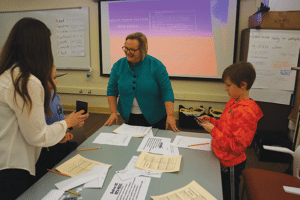Why Is It Difficult to Teach My Child with Autism How to Solve Math Word Problems?
In this blog, Dr. Peggy Schaefer Whitby provides answers to parents top 5 questions. Dr. Schaefer Whitby is the author of Solve It! Teaching Mathematical Word Problem Solving to Students with Autism Spectrum Disorder. She conducts workshops with parents and teachers across the U.S. on teaching mathematical word problem solving to students with autism spectrum disorder (ASD).
Parents have questions about teaching their child with ASD how to solve math word problems. Above all, their top question is, “Why is it so difficult to teach their child how to solve these types of math problems?” In addition, they have many questions related to how they can help their child succeed. Moreover, they have questions about how they can work with schools to help their child.
Top Question 1: My child with ASD does well in math. However, she struggles with math word problems. As a result, the teacher says she may fail math class. Why is it difficult to teach my child how to solve math word problems?
Dr. Schaefer Whitby: Mathematics can be challenging for many students. Math word problems pose even greater difficulty because they require computation skills in addition to reading skills and applied problem-solving skills.
Students with high-functioning ASD have unique academic achievement profiles. [See, for example, Whitby and Mancil (2009), https://www.semanticscholar.org/paper/Academic-Achievement-Profiles-of-Children-with-High-Whitby-Mancil/2b7ae9cc33c03e21dc931da76508125d9bec4a89.] These students may struggle with math word problems even though they have high reading decoding and mathematical computation skills. That is because their difficulty may be affected by characteristics commonly seen in students with ASD. For example
- Reading comprehension difficulties (see, for instance, Williamson, Carnahan, and Jacobs [2012], https://journals.sagepub.com/doi/10.1177/001440291207800404)
- Executive function deficits (see, for example, Happe, Booth, Charlton, & Hughes [2006], https://www.ncbi.nlm.nih.gov/pubmed/16682102)
- Central coherence weaknesses ( see examples in Happe and Booth [2008], https://journals.sagepub.com/doi/abs/10.1080/17470210701508731?journalCode=qjpd)
Top Question 2: Why does Solve It! work?
Dr. Schaefer Whitby: Fortunately, my research on the Solve It! approach shows promise for students with ASD. [Read more at Whitby (2012), https://journals.sagepub.com/doi/abs/10.1177/1088357612468764?journalCode=foab]
Solve It! reflects what good math word problem solvers do. In other words, they use cognitive and metacognitive strategies. Dr. Marjorie Montague’s extensive research on math word problem solving (https://www.exinn.net/wp-content/uploads/2015/10/Brief-on-SolveIt-Research-4-Web.pdf) identified 7 cognitive steps:
- Read and Paraphrase (Steps 1 & 2): students translate the problem.
- Visualize (Step 3): students integrate details to identify the problem.
- Hypothesize and Estimate (Steps 4 & 5): students plan a solution.
- Compute and Check (Steps 6 & 7): students complete the problem.
Montague also identified 3 metacognitive steps–Say, Ask, and Check–that efficient and effective mathematical problem solvers use. These cognitive and metacognitive steps are the foundation of Solve It!
Characteristics often associated with ASD may impede math word problem solving. This is especially the case as the problem increases in complexity. Characteristics include executive functioning difficulties, weak central coherence, reading comprehension, and theory of mind. Solve It! uses strong, evidence-based instructional components to teach the cognitive and metacognitive strategies. Examples include explicit instruction, self-monitoring, mnemonics, and schema-based instruction. This well-structured instructional program supports students with characteristics often associated with ASD.
Top Question 3: Seven steps seems like a lot to solve a math word problem. Does my child need to learn all seven steps?
Dr. Schaefer Whitby: Seven steps may seem like a lot of work to solve one math word problem. Above all, keep this in mind: The approach is based on what good problem solvers do to solve word problems.
Moreover, research to support Solve It! is based on using all seven steps. If we expect the strategy to work, we need to implement it as it is intended. Furthermore, we need to model and teach all of the Solve It! steps. And, we need to require students to complete each step.
Initially, it might take students more time to solve each word problem. However, over time, their accuracy will improve. This is because once students are proficient in using Solve It!, they will use it more naturally and at a faster pace.
Top Question 4: Can Solve It! be used with the general school curriculum?
Dr. Schaefer Whitby: Solve It! Teaching Mathematical Word Problems to Students with ASD is a stand-alone curriculum. The main reason is that students who struggle with mathematical word problem solving often need more time learning how to solve them. For these students, I suggest starting with small-group, explicit instruction.
After the student knows the Solve It! strategy, it is best to model and embed the strategy into the general school curriculum. This allows teachers to add an instructional strategy without adding extensive work. [See the Solve It! versions (https://www.exinn.net/solve-it/) for Inclusive Classrooms for information on how to embed the approach into the general math curriculum. Also, read the Solve It! blog on the topic at https://www.exinn.net/embed-solve-it-in-the-math-curriculum/]
Top Question 5: The school is working with my child on math word problems to no avail. What should I do?
Dr. Schaefer Whitby: This must be frustrating for you, your child, and your child’s teacher! Talk with the teacher. Suggest cognitive strategy instruction as an evidence-based approach for teaching math word problem solving. Likewise, remember that your child’s teacher is following a specific curriculum that may or may not include cognitive strategies.
If your child is not responding to the classroom curriculum, encourage teachers to bring in other resources. If your child has an individualized education program (IEP), encourage the IEP team to consider cognitive strategy instruction. In short, there is nothing wrong with suggesting that they take a look at Solve It! It is evidence-based, validated for all types of learners, and may be just what your child needs to solve math word problems.
More About Dr. Schaefer Whitby
Dr. Schaefer Whitby is a national expert in teaching students with autism spectrum disorders (ASD). As an associate professor at the University of Arkansas, she specializes in educating students with ASD and is passionate about ensuring that they receive evidence-based services. She believes that individuals with ASD have much to offer and that they may need appropriate educational supports to reach their full potential.
Have Questions About Solve It!?
Solve It! Teaching Mathematical Word Problem Solving to Students with Autism Spectrum Disorder focuses on the unique challenges faced by high-functioning students with ASD. It embeds accommodations for students with ASD into the standard Solve It! approach. Learn more at https://www.exinn.net/solve-it-2/


